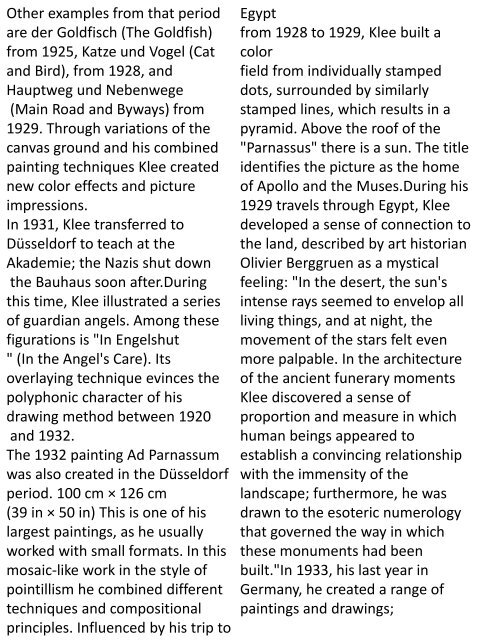Aziz Art July 2019
History of art(west and middle east)- contemporary art ,art ,contemporary art ,art-history of art ,iranian art ,iranian contemporary art ,middle east art ,european art
History of art(west and middle east)- contemporary art ,art ,contemporary art ,art-history of art ,iranian art ,iranian contemporary art ,middle east art ,european art
Create successful ePaper yourself
Turn your PDF publications into a flip-book with our unique Google optimized e-Paper software.
Other examples from that period<br />
are der Goldfisch (The Goldfish)<br />
from 1925, Katze und Vogel (Cat<br />
and Bird), from 1928, and<br />
Hauptweg und Nebenwege<br />
(Main Road and Byways) from<br />
1929. Through variations of the<br />
canvas ground and his combined<br />
painting techniques Klee created<br />
new color effects and picture<br />
impressions.<br />
In 1931, Klee transferred to<br />
Düsseldorf to teach at the<br />
Akademie; the Nazis shut down<br />
the Bauhaus soon after.During<br />
this time, Klee illustrated a series<br />
of guardian angels. Among these<br />
figurations is "In Engelshut<br />
" (In the Angel's Care). Its<br />
overlaying technique evinces the<br />
polyphonic character of his<br />
drawing method between 1920<br />
and 1932.<br />
The 1932 painting Ad Parnassum<br />
was also created in the Düsseldorf<br />
period. 100 cm × 126 cm<br />
(39 in × 50 in) This is one of his<br />
largest paintings, as he usually<br />
worked with small formats. In this<br />
mosaic-like work in the style of<br />
pointillism he combined different<br />
techniques and compositional<br />
principles. Influenced by his trip to<br />
Egypt<br />
from 1928 to 1929, Klee built a<br />
color<br />
field from individually stamped<br />
dots, surrounded by similarly<br />
stamped lines, which results in a<br />
pyramid. Above the roof of the<br />
"Parnassus" there is a sun. The title<br />
identifies the picture as the home<br />
of Apollo and the Muses.During his<br />
1929 travels through Egypt, Klee<br />
developed a sense of connection to<br />
the land, described by art historian<br />
Olivier Berggruen as a mystical<br />
feeling: "In the desert, the sun's<br />
intense rays seemed to envelop all<br />
living things, and at night, the<br />
movement of the stars felt even<br />
more palpable. In the architecture<br />
of the ancient funerary moments<br />
Klee discovered a sense of<br />
proportion and measure in which<br />
human beings appeared to<br />
establish a convincing relationship<br />
with the immensity of the<br />
landscape; furthermore, he was<br />
drawn to the esoteric numerology<br />
that governed the way in which<br />
these monuments had been<br />
built."In 1933, his last year in<br />
Germany, he created a range of<br />
paintings and drawings;

















